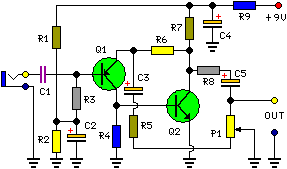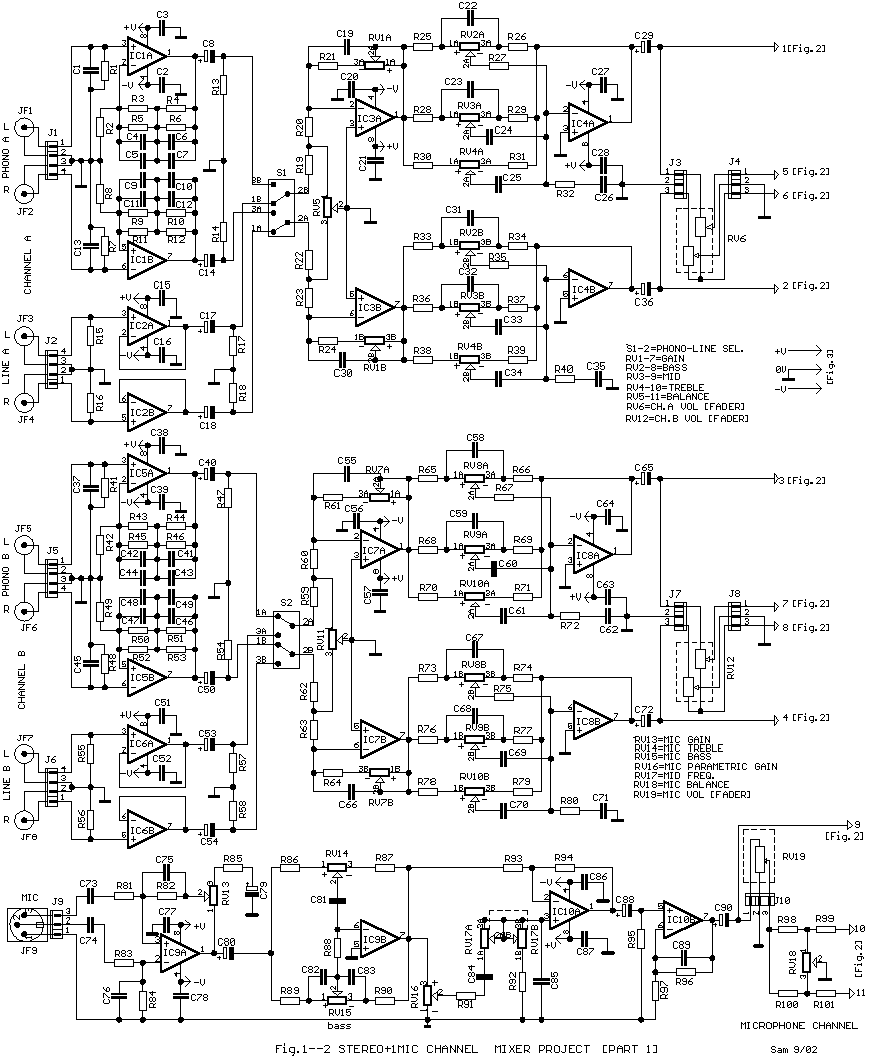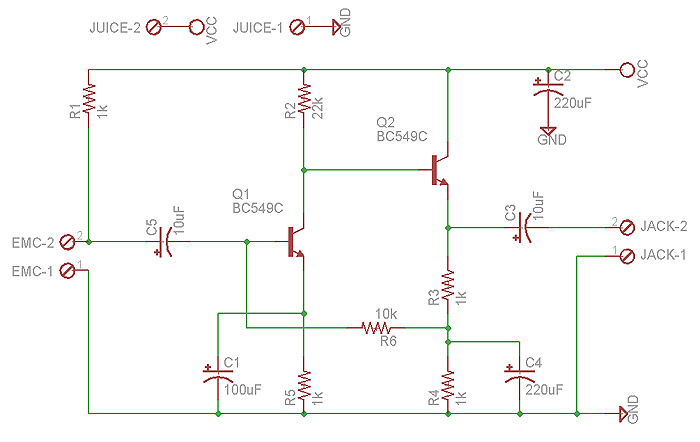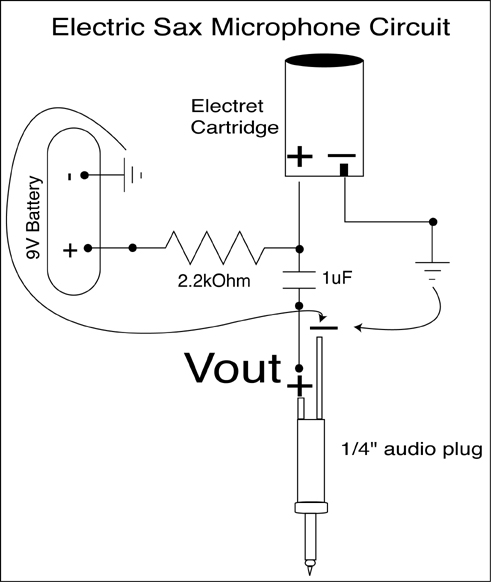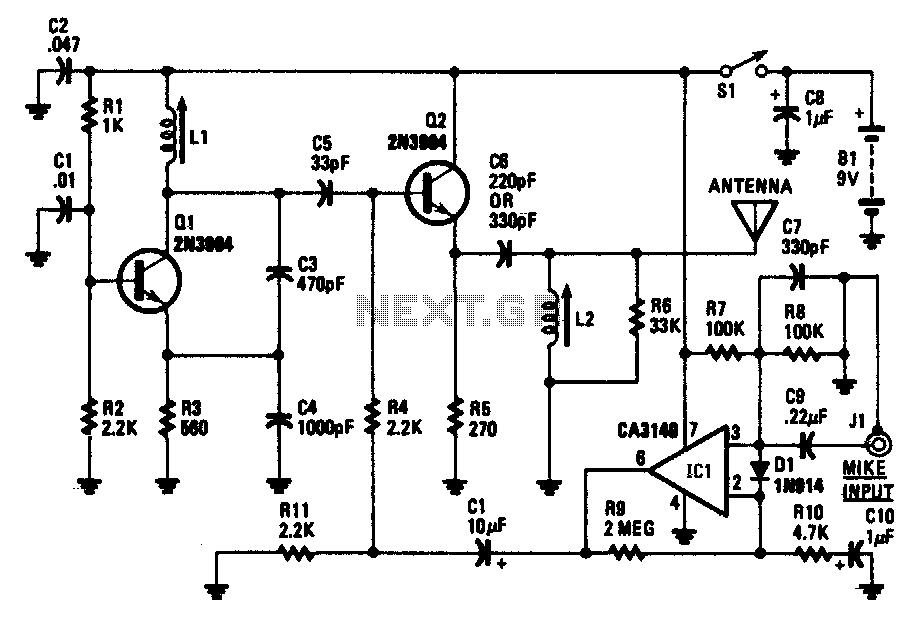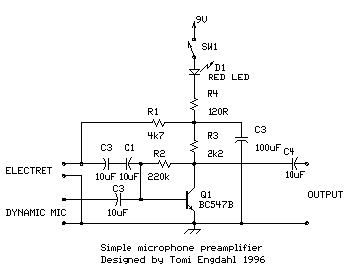
microphone CAD equitek E100
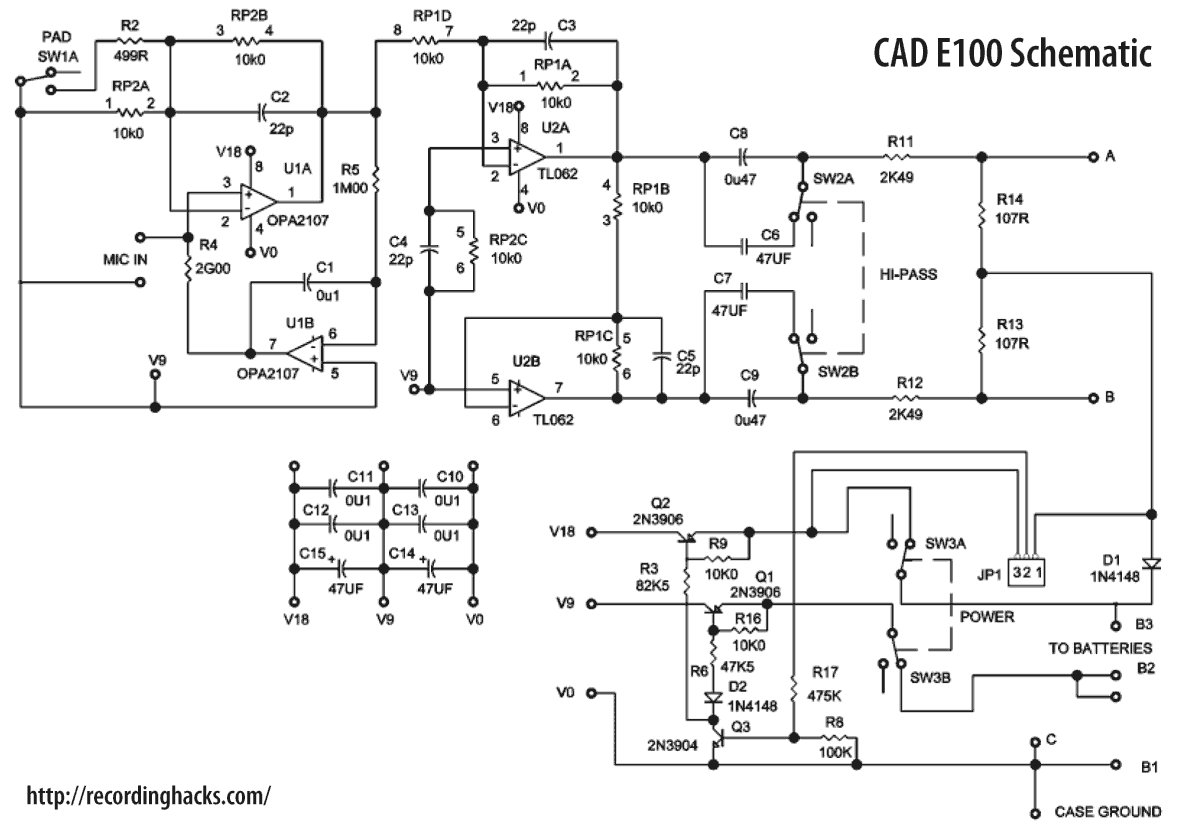
CAD's original E100 microphone was an affordable multi-purpose studio condenser microphone featuring an electret capsule and a neutral sound profile. As part of CAD's Equitek series, the E100 incorporated an innovative transformerless amplifier circuit design. Unlike typical FET (field effect transistor) condenser microphones that utilize discrete designs requiring careful transistor matching for optimal characteristics, the Equitek microphones employed a different method. Instead of discrete FETs, advanced high-speed operational amplifiers (OpAmps) were used. These OpAmps are individually laser-trimmed for maximum performance and exhibit very high gain, allowing for substantial negative feedback that significantly reduces non-linearity. During transient signals, these OpAmps may demand more current than conventional phantom power supplies can provide. This requirement is met through a unique power supply design that charges a pair of rechargeable batteries using phantom power. This system creates a substantial current reserve for the microphone's electronics without requiring maintenance, as the microphone automatically recharges the batteries during operation. According to the schematics, the OpAmp used in the microphone's output circuit is an OPA2107, manufactured by Burr-Brown and currently produced by Texas Instruments. The microphone can be powered by 48V phantom power or by two user-supplied 9V batteries, which are distinct from the rechargeable batteries integrated into the amplifier circuit. The E100 capsule is a back-electret design produced by a company called Primo, although it was eventually discontinued; the revised edition of the microphone utilized a different, smaller electret capsule. The capsule is shock-mounted within the microphone's headbasket. The E100's body is constructed of metal, while the grille is made of brass. An inner, finer screen of stainless steel serves as a pop and EMI filter, and the Primo capsule also features an integrated pop filter. Each microphone is accompanied by its own frequency response plot, demonstrating a flat response (± 1dB) between 10Hz and approximately 7kHz, with a -6dB drop by around 15kHz and roughly -8dB by 20kHz. The E100 was also available as matched pairs, designated CAD part number E100MP, which were shipped in a padded hardshell plastic carrying case, with the microphones hand-matched for output level and frequency response.
The CAD E100 microphone design emphasizes advanced audio performance through its transformerless amplifier circuit and the use of high-speed operational amplifiers. The OPA2107 OpAmp, known for its low noise and high slew rate, plays a crucial role in maintaining audio fidelity. The laser trimming of each OpAmp further enhances performance by ensuring that the operational characteristics are optimized for the specific application within the microphone. The unique power supply design not only allows for extended operation times but also ensures that the microphone can handle dynamic audio signals without distortion, which is particularly beneficial in studio environments where sound clarity is paramount.
The microphone's construction materials—metal for the body and brass for the grille—contribute to durability while also affecting the acoustic properties. The stainless steel inner screen not only filters out unwanted noise but also provides a level of protection for the sensitive electret capsule. The back-electret design of the capsule allows for a more compact form factor while still delivering high-quality sound reproduction, making the E100 suitable for various recording applications.
The frequency response characteristics indicate that the E100 is capable of capturing a wide range of audio frequencies, making it versatile for different sound sources, from vocals to instruments. The availability of matched pairs further enhances its utility in professional settings, where consistency in sound quality is critical. The padded carrying case ensures safe transport and storage, making the E100 a practical choice for both studio and live performance applications. Overall, the CAD E100 microphone represents a significant advancement in studio microphone technology, providing users with a reliable tool for high-quality audio recording.CAD`s original E100 microphone was an inexpensive (for its time) multi-purpose studio condenser microphone, with an electret capsule and a neutral sound profile. Part of CAD`s Equitek series, the E100 had an innovative transformerless amplifier circuit design. Typical FET (field effect transistor) condenser microphones use discrete designs. Thi s means they use individual transistors that must be carefully matched for proper characteristics. Even with careful matching, discrete designs are inherently nonlinear. Equitek microphones use a different approach. We do not use any discrete FETs. Instead, we use advanced high speed OpAmps (Operational Amplifiers). These OpAmps are individually laser trimmed for optimum performance and have very high gain. This allows a large amount of negative feedback to be used to significantly reduce any non-linearity. During transients, these OpAmps may require more current than typical phantom power supplies can deliver.
The extra current demands are accommodated by our unique power supply design. Instead of using phantom power to operate the microphone, we use it to charge a pair of rechargeable batteries. This system creates a huge current reserve for the microphone`s electronics, yet there is no maintenance involved because the microphone automatically keeps the batteries charged during use.
The OpAmp in the mic`s output circuit is an OPA2107, according to the schematics. The OPA2107 was manufactured by Burr-Brown, and is currently made by Texas Instruments. The mic could be powered by 48V phantom power, or by two 9V user-supplied batteries (not to be confused with the rechargeable batteries built into the amp circuit). The E100 capsule was a back-electret design manufactured by a company called Primo. (The capsule was eventually discontinued; the revised edition of the microphone used a different, smaller electret capsule.
) The capsule was shockmounted within the microphone headbasket. The E100 body was metal. The grille was made of brass. An inner, finer screen made of stainless steel acted as a pop and EMI filter. The Primo capsule also had an integrated pop filter of some sort. Each microphone is issued with its own frequency response plot and this showed the mic to be flat ( ± 1dB) between 10Hz and about 7kHz. It fell to -6dB by about 15kHz and was roughly -8dB by 20kHz. The E100 was also available in matched pairs, CAD p/n E100MP. This kit shipped in a padded hardshell plastic carrying case; the mics were hand-matched for output level and frequency response.
🔗 External reference
The CAD E100 microphone design emphasizes advanced audio performance through its transformerless amplifier circuit and the use of high-speed operational amplifiers. The OPA2107 OpAmp, known for its low noise and high slew rate, plays a crucial role in maintaining audio fidelity. The laser trimming of each OpAmp further enhances performance by ensuring that the operational characteristics are optimized for the specific application within the microphone. The unique power supply design not only allows for extended operation times but also ensures that the microphone can handle dynamic audio signals without distortion, which is particularly beneficial in studio environments where sound clarity is paramount.
The microphone's construction materials—metal for the body and brass for the grille—contribute to durability while also affecting the acoustic properties. The stainless steel inner screen not only filters out unwanted noise but also provides a level of protection for the sensitive electret capsule. The back-electret design of the capsule allows for a more compact form factor while still delivering high-quality sound reproduction, making the E100 suitable for various recording applications.
The frequency response characteristics indicate that the E100 is capable of capturing a wide range of audio frequencies, making it versatile for different sound sources, from vocals to instruments. The availability of matched pairs further enhances its utility in professional settings, where consistency in sound quality is critical. The padded carrying case ensures safe transport and storage, making the E100 a practical choice for both studio and live performance applications. Overall, the CAD E100 microphone represents a significant advancement in studio microphone technology, providing users with a reliable tool for high-quality audio recording.CAD`s original E100 microphone was an inexpensive (for its time) multi-purpose studio condenser microphone, with an electret capsule and a neutral sound profile. Part of CAD`s Equitek series, the E100 had an innovative transformerless amplifier circuit design. Typical FET (field effect transistor) condenser microphones use discrete designs. Thi s means they use individual transistors that must be carefully matched for proper characteristics. Even with careful matching, discrete designs are inherently nonlinear. Equitek microphones use a different approach. We do not use any discrete FETs. Instead, we use advanced high speed OpAmps (Operational Amplifiers). These OpAmps are individually laser trimmed for optimum performance and have very high gain. This allows a large amount of negative feedback to be used to significantly reduce any non-linearity. During transients, these OpAmps may require more current than typical phantom power supplies can deliver.
The extra current demands are accommodated by our unique power supply design. Instead of using phantom power to operate the microphone, we use it to charge a pair of rechargeable batteries. This system creates a huge current reserve for the microphone`s electronics, yet there is no maintenance involved because the microphone automatically keeps the batteries charged during use.
The OpAmp in the mic`s output circuit is an OPA2107, according to the schematics. The OPA2107 was manufactured by Burr-Brown, and is currently made by Texas Instruments. The mic could be powered by 48V phantom power, or by two 9V user-supplied batteries (not to be confused with the rechargeable batteries built into the amp circuit). The E100 capsule was a back-electret design manufactured by a company called Primo. (The capsule was eventually discontinued; the revised edition of the microphone used a different, smaller electret capsule.
) The capsule was shockmounted within the microphone headbasket. The E100 body was metal. The grille was made of brass. An inner, finer screen made of stainless steel acted as a pop and EMI filter. The Primo capsule also had an integrated pop filter of some sort. Each microphone is issued with its own frequency response plot and this showed the mic to be flat ( ± 1dB) between 10Hz and about 7kHz. It fell to -6dB by about 15kHz and was roughly -8dB by 20kHz. The E100 was also available in matched pairs, CAD p/n E100MP. This kit shipped in a padded hardshell plastic carrying case; the mics were hand-matched for output level and frequency response.
🔗 External reference
Warning: include(partials/cookie-banner.php): Failed to open stream: Permission denied in /var/www/html/nextgr/view-circuit.php on line 713
Warning: include(): Failed opening 'partials/cookie-banner.php' for inclusion (include_path='.:/usr/share/php') in /var/www/html/nextgr/view-circuit.php on line 713
